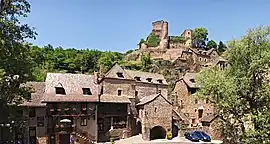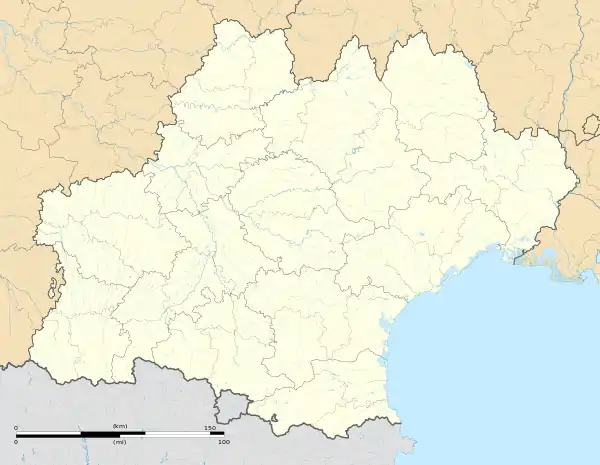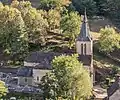Belcastel
| |
|---|---|
 A view of Belcastel | |
.svg.png.webp) Coat of arms | |
Location of Belcastel | |
 Belcastel  Belcastel | |
| Coordinates: 44°23′22″N 2°20′16″E / 44.3894°N 2.3378°E | |
| Country | France |
| Region | Occitania |
| Department | Aveyron |
| Arrondissement | Villefranche-de-Rouergue |
| Canton | Enne et Alzou |
| Intercommunality | Pays Rignacois |
| Government | |
| • Mayor (2020–2026) | Jean-Louis Bessiere[1] |
| Area 1 | 10.74 km2 (4.15 sq mi) |
| Population | 192 |
| • Density | 18/km2 (46/sq mi) |
| Time zone | UTC+01:00 (CET) |
| • Summer (DST) | UTC+02:00 (CEST) |
| INSEE/Postal code | 12024 /12390 |
| Elevation | 391–707 m (1,283–2,320 ft) (avg. 450 m or 1,480 ft) |
| 1 French Land Register data, which excludes lakes, ponds, glaciers > 1 km2 (0.386 sq mi or 247 acres) and river estuaries. | |
Belcastel (French pronunciation: [bɛlkastɛl]; Occitan: Bèlcastèl) is a commune in the Aveyron department in the Occitania region in Southern France.
The village is medieval in character, with cobbled streets and lauze-roofed (stone tiled) houses. The bulk of the village and the castle (Château de Belcastel) are situated on the steep north bank of the river Aveyron. Several buildings including the 15th-century church are on the south side of the river, with a similarly aged bridge connecting the two.
A ruined fort, the Fort du Lourdou, can also be found about a kilometre west of the village on the south bank of the river at the Roc d'Anglars. Belcastel was nominated as one of the "most beautiful villages of France" (Les Plus Beaux Villages de France) in 1990; the local council regularly hosts watercolour competitions and art exhibitions during the summer.
Demographics
| Year | Pop. | ±% p.a. |
|---|---|---|
| 1968 | 280 | — |
| 1975 | 266 | −0.73% |
| 1982 | 249 | −0.94% |
| 1990 | 245 | −0.20% |
| 1999 | 251 | +0.27% |
| 2009 | 225 | −1.09% |
| 2014 | 192 | −3.12% |
| 2020 | 193 | +0.09% |
| Source: INSEE[3] | ||
Gallery
 Saint Mary Magdalene church (Église Sainte-Marie-Madeleine)
Saint Mary Magdalene church (Église Sainte-Marie-Madeleine) 15th-century bridge (Vieux Pont)
15th-century bridge (Vieux Pont) Château de Belcastel
Château de Belcastel Le Lourdou on the river
Le Lourdou on the river
See also
References
- ↑ "Répertoire national des élus: les maires". data.gouv.fr, Plateforme ouverte des données publiques françaises (in French). 9 August 2021.
- ↑ "Populations légales 2021". The National Institute of Statistics and Economic Studies. 28 December 2023.
- ↑ Population en historique depuis 1968, INSEE